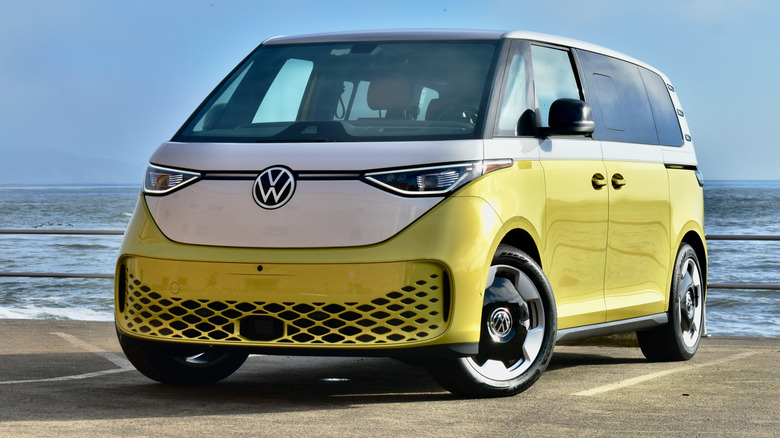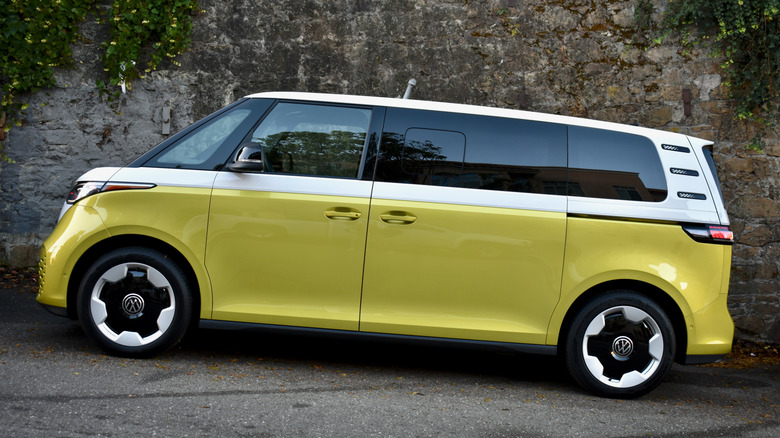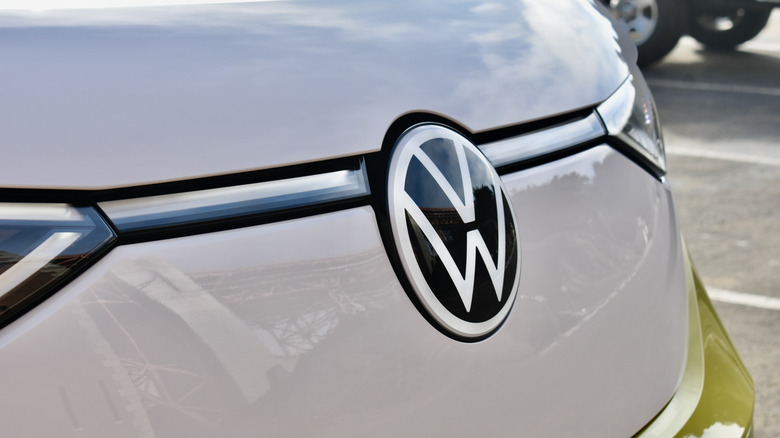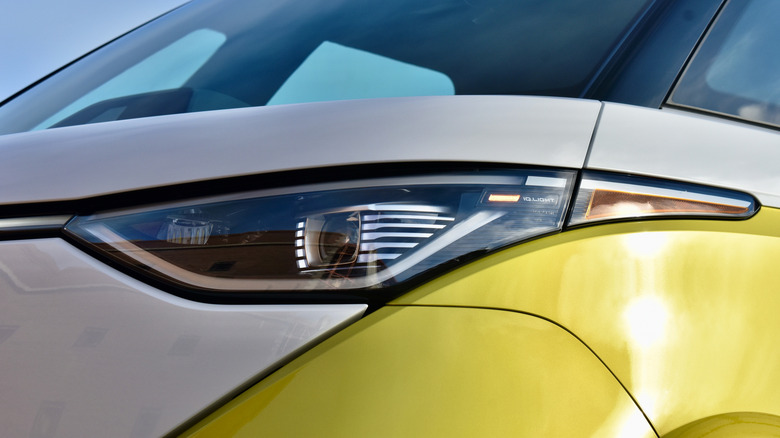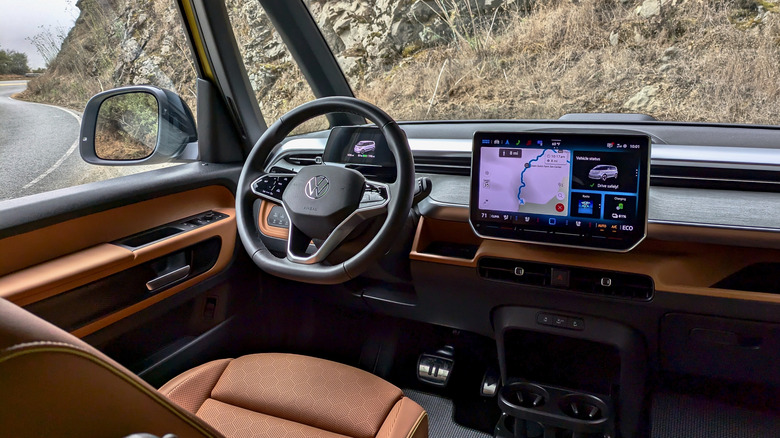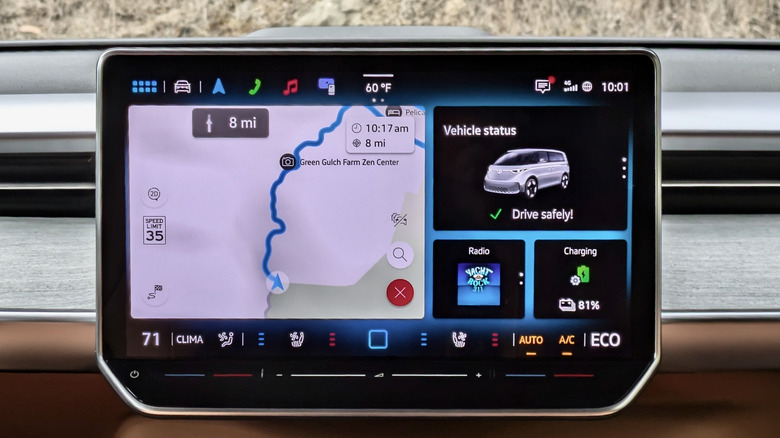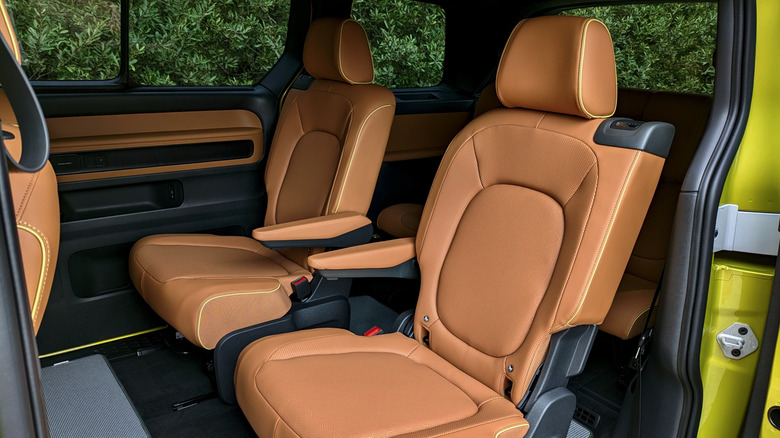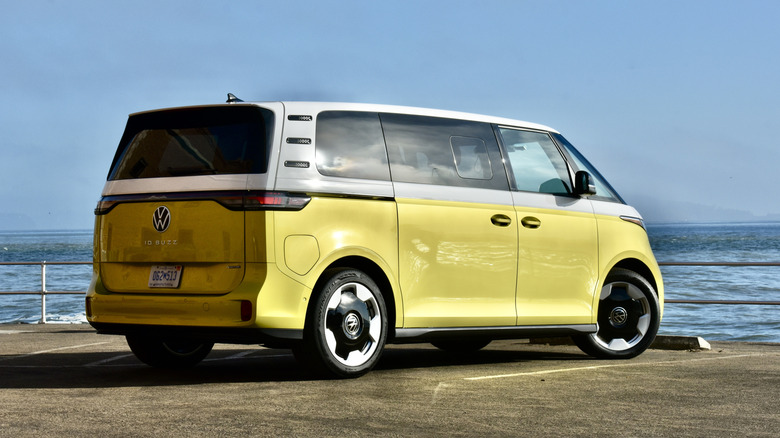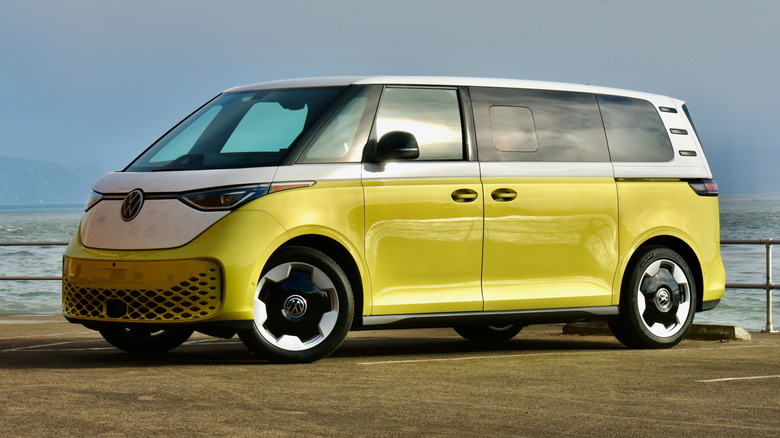2025 VW ID. Buzz First Drive: Microbus Revival Trades Flower Power For Electric Power
The last few years have seen many highly-anticipated EV launches, but no EV has had as much buildup as the 2025 Volkswagen ID. Buzz. Billed as the modern reincarnation of the Volkswagen Microbus—as much an icon of 1960s hippie culture as the peace sign—this electric van's gestation actually predates the modern EV era.
When Volkswagen introduced the New Beetle in the late 1990s to great fanfare, a revival of the Microbus—the automaker's other great icon—seemed like a logical next step. Instead, the new Microbus became an on again, off again project for two decades. And where the original Microbus started out as a utilitarian vehicle, the ID. Buzz is a style statement.
"It's a brand symbol, it's a halo car," VW Group of America CEO Pablo Di Si said in a presentation ahead of the ID. Buzz U.S. media drive in San Francisco, where the automaker hosted SlashGear. A halo car is usually a niche model that casts a brand in a good light (think Chevrolet Corvette), rather than a volume seller. But that doesn't mean the ID. Buzz is just a decorative bauble for showrooms. It's also a good car.
It's been a while
The original Volkswagen Type 2 Microbus faded away from the U.S. market in the 1970s, but continued in other markets until 2013, when the last examples were built in Brazil. For U.S. car buyers, the road from classic 'Bus to modern 'Buzz has been as long and convoluted as a Bob Dylan lyric.
Fresh off the success of the New Beetle, Volkswagen showed a Microbus concept at the 2001 Detroit auto show. Further concepts called Bulli and Budd-e followed in 2011 and 2016, respectively, with the Budd-e introducing the idea of electric power.
The ID. Buzz was first shown in concept form in January 2017 at the Detroit auto show, serving as a helpful distraction from the then-recent "Dieselgate" scandal. Production for the European market began in 2022, and VW showed what would become the U.S.-spec version in 2023. But the ID. Buzz is only just now going on sale stateside.
Buzz-worthy design
Based on the smiles and excited questioning from passersby, the novelty of ID. Buzz's retro styling doesn't seem to have worn off despite the long wait for its arrival. Right now, you'll get less attention driving a Lamborghini.
While it's a much larger vehicle than the original Microbus (what vehicle hasn't grown bigger over the years?), the ID. Buzz maintains its cuteness and approachability thanks to a similar one-box profile with a rounded prow in place of a protruding hood and posturing grille. The Microbus looked this way because of its rear-mounted engine, but it's also a good advertisement of the ID. Buzz's electric powertrain. The retro look is enhanced by standard 20-inch alloy wheels made to look like old-school steel wheels with hubcaps, and available two-tone paint.
At the same time, in keeping with the ID. Buzz's role as the brand's EV halo model, some styling cues from other VW ID models carry over. The headlights and textured lower air intake are definitely ID.4-like, for example, although they do work well with the overall design.
How much space do you actually get?
The design might be what gets the most attention, but the ID. Buzz offers a major advantage over previous retro cars like the New Beetle and Mini — as well as most other current EVs — when it comes to practicality. It's one of only a handful of three-row EVs currently on sale (most of the others are pricier luxury models) and the only van, offering sliding doors and a low step-in height for easier access.
Volkswagen sells two-row passenger models and even cargo van variants in other markets, but the only configuration available in the U.S. is a long wheelbase, three-row passenger van that stretches nearly 10 inches longer than the two-row model. At 192.4 inches long, the ID. Buzz is 8.3 inches shorter than a VW Atlas—the only other three-row model the automaker sells in the U.S. It's also about as wide as an Atlas, but five inches taller.
The van body style means the ID. Buzz offers much more third-row legroom than a Kia EV9. The larger windows and lower floor make sitting back there more pleasant, too. With the second and third rows folded, the VW offers 145.5 cubic feet of cargo space that's comparable to gasoline minivans, but the Kia has more cargo space behind its third row, plus a frunk that makes hauling both passengers and their stuff easier.
The interior vibes are all off
The ID. Buzz definitely feels like a van from behind the wheel. You sit high and upright, almost like being perched on a bar stool. However, the windshield is very far away, which makes forward visibility not much better than in a vehicle with a conventional hood. The deep dashboard created to fill this space also necessitated massive quarter windows, which at least make it easier to see when going around corners.
Like the exterior, the unusual interior layout is balanced out by familiar features from other ID.4 models. Where the steering wheels of vintage Microbuses look like they were salvaged from ocean liners, here you get the same wheel design as in the ID.4 and other recent VW models. The ID.4's twist shifter and freestanding gauge pod and touchscreen make an appearance as well.
Some additional retro touches would have been welcome, if only to distract from the underwhelming interior materials. The hard, tinny plastics would be fine in the more basic models sold in other markets, but not in our U.S.-market test car, which commands a retail price of just over $70,000. You don't even get real leather upholstery at that price.
Aging hippies will also be disappointed to find that there aren't many good stash places. Shelves on the dashboard, doors panels, and center console leave valuables—illicit or otherwise—out in the open, with little covered storage space.
Latecomer gets better tech
As a later addition to the ID family, the ID. Buzz benefits from Volkswagen having worked out some of the software kinks of earlier models. It comes standard with the 12.9-inch touchscreen that debuted in the ID.4 for the 2024 model year, with vibrant graphics and without the latency issues of previous versions. Swiping and tapping from menu to menu was as easy as a tablet.
A 5.3-inch digital instrument cluster is also standard, along with wireless Apple CarPlay and Android Auto, WiFi, and seven USB ports spread across all three rows. VW also includes a USB-C dashcam port, as well as a 110-volt outlet that should come in handy when camping. Higher trim levels add a head-up display and a 14-speaker Harman/Kardon audio system.
Another carryover feature from the ID.4 is ID.Light, which aims to repurpose interior ambient lighting for useful purposes. It will, for example, illuminate the left or right side of the dashboard to indicate the next turn when using the navigation system. That's helpful if you've already familiarized yourself with ID.Light's cues, otherwise it's just confusing.
The ID. Buzz also comes standard with the expected array of driver-assist features, such as forward-collision warning, adaptive cruise control, lane-keep assist, and Travel Assist, a hands-on highway driving assistant. A 360-degree camera system is also available, but we found the resolution to be subpar.
Power exceeds expectations, but range doesn't
Just as the Microbus borrowed its basic underpinnings and rear-mounted, air-cooled engine from the Volkswagen Beetle, the ID. Buzz shares the MEB platform with the ID.4 and comes standard with a rear-mounted motor driving the back wheels. It's the upgraded AP550 unit introduced with a recent refresh of the ID.4, making 282 horsepower and 413 pound-feet of torque.
An all-wheel drive version is also available, adding a second motor at the front that brings total system output to 335 hp. This motor also generates 99 lb-ft of torque, but VW doesn't quote a combined figure for both motors. The automaker estimates a zero to 60 mph time of 6.0 seconds for all-wheel drive models—we have no reason to dispute based on our subjective experience—while the top speed of all ID. Buzz models is electronically limited to 99 mph.
Regardless of powertrain, the ID. Buzz comes with a 91-kilowatt-hour battery pack that provides 234 miles of range with rear-wheel drive and 231 miles with all-wheel drive. Those figures are a bit disappointing given the size of the pack, and a reminder that the MEB platform was engineered for volume production first and efficiency second.
The ID. Buzz can at least DC fast charge at a reasonable 200 kilowatts, meaning a 10-80% charge should still only take 26 minutes, according to VW (and the sliding door won't move all the way back, if the charge port is open at the time). An 11.2 kW AC charger is also included for home use. That charging capability should make the ID. Buzz more practical than the range figures suggest.
It doesn't drive like a van
Based on previous experience with the ID.4, it's clear that VW's MEB architecture can produce competent—if not necessarily exciting—EVs. But stretching it and raising the center of gravity to create the ID. Buzz could have compromised that. So, we were pleasantly surprised when we got behind the wheel and pointed the Buzz's blunt nose toward California's coastal route 1.
Our all-wheel drive Buzz's energetic acceleration was matched by drama-free suspension that kept body roll in check, combined with quick steering. The tradeoff was damping that felt a bit on the firm side, although this also helped give the Buzz a feeling of solidity that's hard to achieve with what is essentially a big metal box. The interior was also remarkably quiet—even by EV standards.
Drive it as it's meant to be driven, and the ID. Buzz is perfectly pleasant and surprisingly rapid. It's still a van, though, so the fun stops when you really push it. The steering is only precise up to a point, and just reacts too slowly at higher speeds, where the lack of brake feel also becomes apparent. This should be less of a problem in an EV, where regenerative braking means not using the brake pedal much of the time, but VW isn't a believer in this so-called one-pedal driving. It's possible to turn up the level of regeneration by shifting from "D" to "B," but even this higher setting isn't very aggressive.
2025 Volkswagen ID. Buzz Verdict
It's fitting that VW staged this test drive in San Francisco because, like the city itself, the modern Microbus is an icon of 1960s counterculture that the average hippie probably can't afford.
The base rear-wheel drive Pro S model starts at $61,545—about the same as a fully-loaded Chrysler Pacifica Hybrid Pinnacle plug-in hybrid. The Pro S Plus costs $63,495 with rear-wheel drive and $69,545 with all-wheel drive. VW is also offering a 1St Edition launch model with special wheels, badging, and some usually-optional features for $67,045 ($71,545 with all-wheel drive).
If you just want an EV with three rows of seats, the Kia EV9 is a more sensible choice. Pricing for the 2025 model year wasn't available at press time, but for 2024 it was possible to get a rear-wheel drive version with similar range and even faster charging than the ID. Buzz for $56,395, or 304 miles of range for $60,695.
As a style statement and halo model for VW's EV line, though, the ID. Buzz hits its mark. It brings back the fun that's been missing from the VW brand lately, and is a much more practical car than the old gasoline Beetle revivals. The ID. Buzz is also less expensive than other attention-seeking EVs like the Tesla Cybertruck and GMC Hummer EV, with a friendlier character that's more likely to solicit thumbs up than middle fingers.
